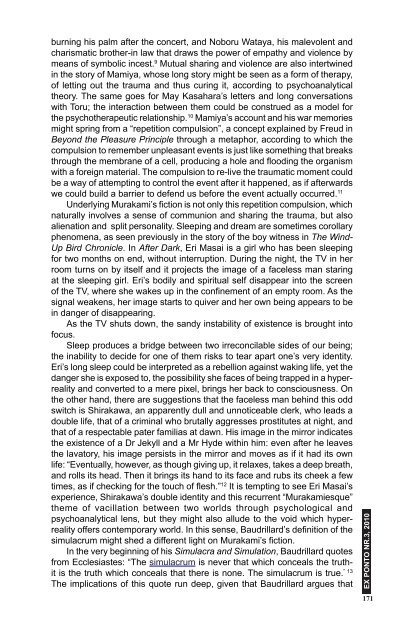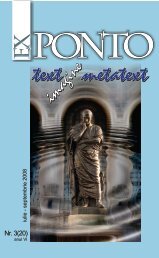Nr. 3 (28) anul VIII / iulie-septembrie 2010 - ROMDIDAC
Nr. 3 (28) anul VIII / iulie-septembrie 2010 - ROMDIDAC
Nr. 3 (28) anul VIII / iulie-septembrie 2010 - ROMDIDAC
Create successful ePaper yourself
Turn your PDF publications into a flip-book with our unique Google optimized e-Paper software.
urning his palm after the concert, and Noboru Wataya, his malevolent and<br />
charismatic brother-in law that draws the power of empathy and violence by<br />
means of symbolic incest. 9 Mutual sharing and violence are also intertwined<br />
in the story of Mamiya, whose long story might be seen as a form of therapy,<br />
of letting out the trauma and thus curing it, according to psychoanalytical<br />
theory. The same goes for May Kasahara’s letters and long conversations<br />
with Toru; the interaction between them could be construed as a model for<br />
the psychotherapeutic relationship. 10 Mamiya’s account and his war memories<br />
might spring from a “repetition compulsion”, a concept explained by Freud in<br />
Beyond the Pleasure Principle through a metaphor, according to which the<br />
compulsion to remember unpleasant events is just like something that breaks<br />
through the membrane of a cell, producing a hole and flooding the organism<br />
with a foreign material. The compulsion to re-live the traumatic moment could<br />
be a way of attempting to control the event after it happened, as if afterwards<br />
we could build a barrier to defend us before the event actually occurred. 11<br />
Underlying Murakami’s fiction is not only this repetition compulsion, which<br />
naturally involves a sense of communion and sharing the trauma, but also<br />
alienation and split personality. Sleeping and dream are sometimes corollary<br />
phenomena, as seen previously in the story of the boy witness in The Wind-<br />
Up Bird Chronicle. In After Dark, Eri Masai is a girl who has been sleeping<br />
for two months on end, without interruption. During the night, the TV in her<br />
room turns on by itself and it projects the image of a faceless man staring<br />
at the sleeping girl. Eri’s bodily and spiritual self disappear into the screen<br />
of the TV, where she wakes up in the confinement of an empty room. As the<br />
signal weakens, her image starts to quiver and her own being appears to be<br />
in danger of disappearing.<br />
As the TV shuts down, the sandy instability of existence is brought into<br />
focus.<br />
Sleep produces a bridge between two irreconcilable sides of our being;<br />
the inability to decide for one of them risks to tear apart one’s very identity.<br />
Eri’s long sleep could be interpreted as a rebellion against waking life, yet the<br />
danger she is exposed to, the possibility she faces of being trapped in a hyperreality<br />
and converted to a mere pixel, brings her back to consciousness. On<br />
the other hand, there are suggestions that the faceless man behind this odd<br />
switch is Shirakawa, an apparently dull and unnoticeable clerk, who leads a<br />
double life, that of a criminal who brutally aggresses prostitutes at night, and<br />
that of a respectable pater familias at dawn. His image in the mirror indicates<br />
the existence of a Dr Jekyll and a Mr Hyde within him: even after he leaves<br />
the lavatory, his image persists in the mirror and moves as if it had its own<br />
life: “Eventually, however, as though giving up, it relaxes, takes a deep breath,<br />
and rolls its head. Then it brings its hand to its face and rubs its cheek a few<br />
times, as if checking for the touch of flesh.” 12 It is tempting to see Eri Masai’s<br />
experience, Shirakawa’s double identity and this recurrent “Murakamiesque”<br />
theme of vacillation between two worlds through psychological and<br />
psychoanalytical lens, but they might also allude to the void which hyperreality<br />
offers contemporary world. In this sense, Baudrillard’s definition of the<br />
simulacrum might shed a different light on Murakami’s fiction.<br />
In the very beginning of his Simulacra and Simulation, Baudrillard quotes<br />
from Ecclesiastes: “The simulacrum is never that which conceals the truthit<br />
is the truth which conceals that there is none. The simulacrum is true. ” 13<br />
The implications of this quote run deep, given that Baudrillard argues that<br />
Ex Ponto nr.3, <strong>2010</strong><br />
171
















